In-Depth Guide to Wired Indoor Security Cameras
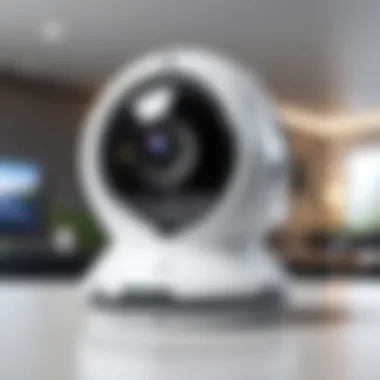
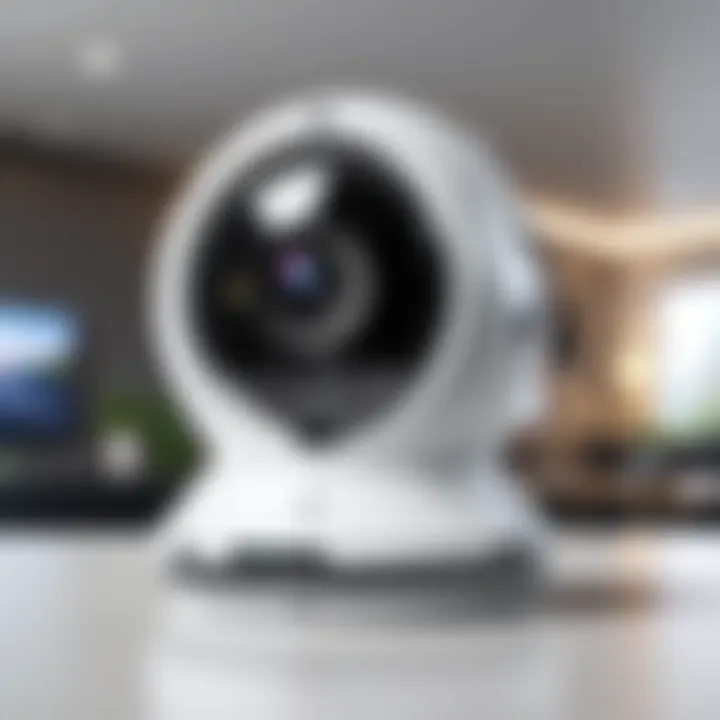
Intro
In today’s evolving landscape of security technology, wired indoor security cameras stand as a pivotal solution for monitoring and protection. This article explores their intricacies, aiming to provide IT professionals and tech enthusiasts a thorough understanding of their functionality, installation, advantages, and disadvantages. With the increasing threats to safety, it becomes vital to choose a robust security system.
Specifically, this examination covers key features, the performance of these devices in various scenarios, and technical specifications that differentiate them from wireless models. Throughout, the focus will remain on how to integrate these systems effectively into broader security setups.
As we venture further, it is essential to grasp the fundamental features that set wired indoor security cameras apart in the market, allowing informed decisions for those responsible for their deployment in commercial or personal environments.
Intro to Wired Indoor Security Cameras
In today's society, security has become a primary concern for both residential and commercial properties. Wired indoor security cameras provide a reliable solution to monitor premises, ensuring safety and protecting assets. The relevance of this topic lies in the evolution of security needs and the technological advancements that have made wired security systems more effective.
Wired systems offer several advantages. One significant benefit is the stability and reliability of a direct connection. Unlike wireless alternatives, wired cameras are less prone to interference from environmental factors or signal barriers. This advantages makes them preferable for high-stakes security scenarios, where continuous monitoring is essential.
From a technical viewpoint, wired cameras often exhibit superior video quality and consistent performance due to the dedicated bandwidth of their connections. Their installation also permits a range of features that can be optimized for specific environments, ensuring that the coverage is tailored to the unique needs of the premises.
However, potential users must also consider several factors before installing such systems. Installation complexity may pose challenges, especially for larger properties. Understanding the correct cabling practices and ensuring adequate power sources are crucial steps that must not be overlooked. The system’s effectiveness relies heavily on proper setup.
Furthermore, while wired cameras may incur initial higher costs due to installation and hardware, they often provide long-term reliability that can justify the investment. For IT professionals and tech enthusiasts, exploring the intricacies of wired indoor security cameras is vital to making informed decisions about their implementation.
"The evolution of wired security cameras reflects a critical shift in safety paradigms, addressing the escalating need for comprehensive surveillance solutions."
In summary, wired indoor security cameras represent a vital component of modern security infrastructure. Their importance is underscored by a solid foundation of technological reliability, better video quality, and a definitive framework for end-users. Understanding these elements ensures that security measures are truly effective in achieving their intended outcomes.
Understanding the Technology Behind Wired Cameras
The technology that underpins wired indoor security cameras is vital for ensuring their effectiveness. Understanding this technology allows IT professionals to make informed choices when selecting systems for surveillance needs. Wired cameras often provide superior reliability compared to wireless options. This is due to their physical connection, which minimizes issues that arise from signal interference or network instability.
Cabling and Connectivity
Types of cables used
The types of cables utilized in wired indoor security cameras are crucial in determining their performance. Generally, two primary types of cables are used: coaxial cables and Ethernet cables. Coaxial cables have been traditionally favored for analog security systems, offering solid shielding against interference. On the other hand, Ethernet cables are commonly used in IP cameras, providing increased bandwidth for high-definition video transmission.
A key characteristic of Ethernet cables is their ability to support Power over Ethernet (PoE). This allows the camera to receive power and data over a single cable, simplifying installation. Moreover, Ethernet cables, specifically those rated as Cat 5e or Cat 6, allow for higher data transfer rates. However, their installation might require additional planning to ensure that the PoE switches are properly positioned.
Installation requirements
The installation requirements for wired cameras are significant for their overall function. This usually includes assessing the necessary lengths of cable, which is important for both reach and signal quality. When planning installations, it's essential to take into account the layout of the environment, which can dictate how cables will be run and hidden.
A primary consideration is ensuring that cables are secured and protected from potential damage. If cables are not appropriately managed, it can lead to issues like degradation over time. A unique feature of wired installations is that they often entail more labor and longer setup times than wireless systems. However, the trade-off is often greater reliability and security from outside interference.
Camera Components and Features
Lenses and image sensors
The lenses and image sensors in security cameras directly influence the quality of the footage captured. Lenses come in various focal lengths, impacting the camera’s field of view. A wide-angle lens can capture a broader area but might sacrifice detail, while a narrow lens provides more detail over a smaller area.
Image sensors are divided into two categories: CCD (Charged Coupled Device) and CMOS (Complementary Metal-Oxide-Semiconductor). CCD sensors are known for their superior image quality, especially in low-light conditions, while CMOS sensors have become more popular due to lower costs and energy efficiency.
Important here is the blending of lens and sensor technology to create systems that excel in capturing clear, detail-oriented video. This combination plays a big role in surveillance effectiveness based on individual site needs.
Resolution and framing
Resolution and framing are central to the effectiveness of any wired security camera. Resolution is typically denoted in pixels; higher pixel counts lead to clearer images. A common format for high-quality recording is 1080p, but many manufacturers now offer 4K options for increased detail.
Framing, on the other hand, refers to the aspect ratio and how the image is composed. Common framing standards like 16:9 are prevalent as they align closely with modern video displays. This alignment ensures that footage is intuitively viewable without additional processing.
Understanding these aspects not only helps in the selection of a security camera but also improves operational efficiency in monitoring while minimizing blind spots.
"Choosing the right camera involves understanding the synergy between the lens, sensor, resolution, and framing. Each factor contributes uniquely to effective surveillance."
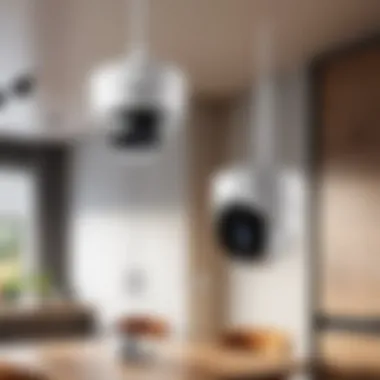
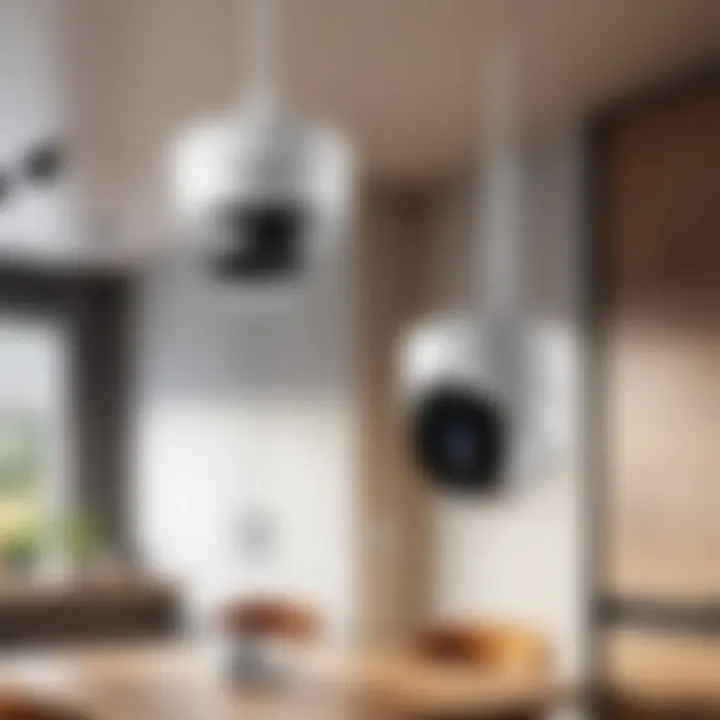
By delving into these technical dimensions, IT professionals can achieve a more strategic approach to deploying wired indoor security cameras, ensuring that security measures are both current and effective.
Comparative Analysis of Wired vs. Wireless Security Camera Systems
The comparative analysis of wired and wireless security camera systems holds significant relevance within the context of this article. Understanding the strengths and weaknesses of each system directly informs decision-making processes for IT professionals and tech enthusiasts. With various technical specifications and requirements, this comparison highlights critical aspects that can markedly affect installation, performance, and overall effectiveness.
Strengths of Wired Systems
Reliability
Reliability stands out as a leading advantage of wired systems. Cabled connections provide a consistent data flow, unaffected by signal interference or power fluctuations often seen in wireless systems. This key characteristic of wired setups ensures that video feeds remain uninterrupted, which is crucial for security surveillance.
The unique feature of reliability in wired systems manifests in their ability to function during adverse conditions, such as poor weather or physical obstructions. Consequently, they remain a popular choice for users needing dependable surveillance, particularly in environments requiring enhanced security measures.
Video quality
Another strength of wired security systems is their superior video quality. Wired cameras often support higher resolutions, translating to clearer, more detailed footage. This key characteristic makes wired systems particularly effective in environments where identifying details in recorded footage is paramount, such as retail spaces or critical infrastructure.
The unique advantage lies in wired systems' consistent bandwidth, promoting seamless transmission of high-resolution video. The trade-off, however, may be that users in specific installations occasionally experience more extensive installation requirements compared to wireless solutions.
Weaknesses of Wired Systems
Installation complexity
Installation complexity is a significant weakness of wired systems. Setting up these systems often involves meticulous planning for cable runs and mounting, which can be daunting for many users. This key characteristic adds potential labor costs and time commitments during installation. While these configurations provide robust performance, they necessitate skilled labor and forethought in layout strategies.
The unique feature of this complexity is that it can also deter some users from selecting wired over wireless options, especially in residential settings where simple DIY solutions are more appealing. This can limit the adoption of wired systems in certain contexts, despite their benefits.
Less flexibility
Less flexibility is another drawback of wired security systems. Once installed, the placement of cameras is mostly fixed, making adjustment or repositioning a challenging task. This inflexibility contrasts sharply with wireless systems, where cameras can be relocated easily without significant modifications.
This unique characteristic reflects a serious consideration for users, especially those who may need to revisit their security layouts based on changing needs. Consequently, those needing versatile security solutions might find wired systems less appealing.
In summary, wired security cameras provide reliability and superior video quality, yet present challenges in installation complexity and flexibility. An informed decision must weigh these aspects carefully against unique situational needs.
Installation Process for Wired Indoor Security Cameras
The installation process of wired indoor security cameras is crucial for the efficacy and performance of any security system. Proper installation ensures that the cameras can function effectively to monitor environments, deter potential threats, and provide quality footage when needed. In this section, we will explore the necessary steps involved in planning and executing a successful installation.
Planning the Installation
Identifying optimal locations
Identifying optimal locations for camera placement is vital for maximizing coverage. One key aspect is to consider areas that require constant surveillance, such as entrances and key internal spaces. Assessing the field of view and potential blind spots is important. For instance, placing the camera too high might lose focus on details, while too low might increase vulnerability to tampering.
Optimal camera placement offers several advantages. First, it ensures comprehensive monitoring, reducing areas that might not be watched. This proactive strategy can deter criminal activities effectively. Key characteristics of optimal locations include accessibility and line of sight preferences.
On the downside, selecting inappropriate spots may require more complex cabling setups, increasing labor intensity and costs. Poor locations could also hinder the camera's effectiveness, rendering them less useful in security measures.
Determining cable runs
Determining cable runs is equally essential as it directly influences installation efficiency. Careful planning helps avoid unnecessary obstacles or long distances that complicate the installation. The choice of the path is a key characteristic, as fewer bends and turns in the cable run reduce signal degradation. In addition, identifying cable runs that are protected from environmental hazards provides durability.
One major advantage of effectively determining cable runs is the simplified installation process. It allows technicians to work smoothly, often reducing the labor required. However, misjudgment of cable runs may lead to increased costs due to re-routing or longer runs than necessary, which can also affect password performance.
Steps for Installation
Mounting cameras
The mounting of wired indoor security cameras involves careful attention to detail. This part of the process includes selecting the mount type and ensuring that it meets the needs of the camera model. One specific aspect is the alignment; if the camera is not installed at the correct angle, it may not capture vital footage.
Proper mounting techniques are beneficial as they contribute to the camera's overall stability. For example, a secure mount will resist weather conditions, vibrations, and potential tampering. One unique feature of a well-mounted camera is its ability to provide different angles of view, depending on the environment. The primary disadvantage includes the time taken to measure and adjust precisely before securing the camera in place.
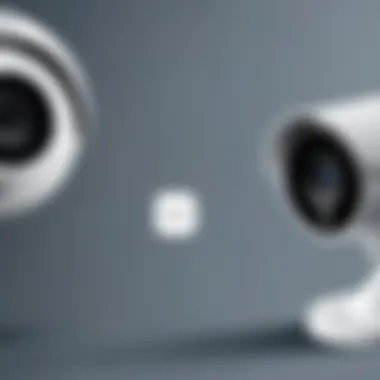
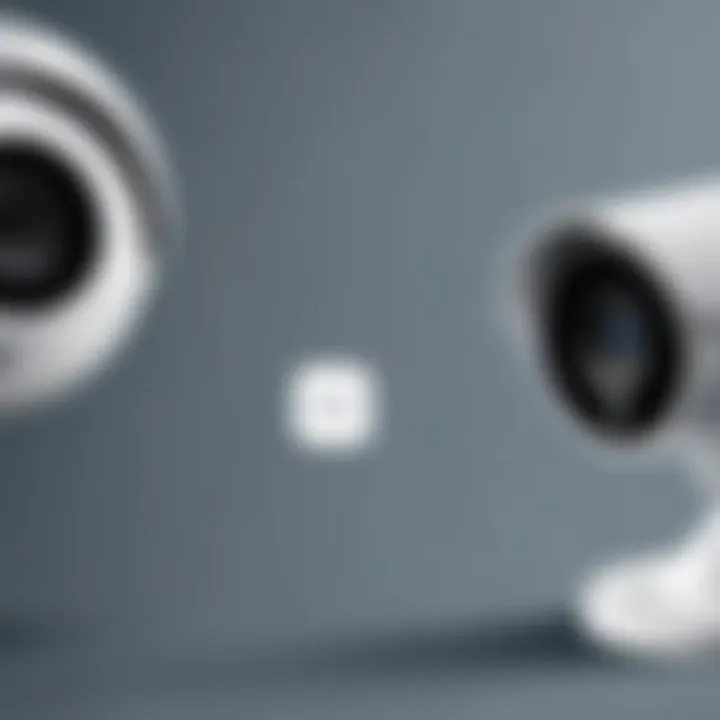
Cabling procedures
Cabling procedures encompass the act of connecting and securing cables, which is foundational to effective camera performance. One specific aspect is ensuring that the cables are both tidy and properly insulated from risks like damage or moisture. Organized cabling reduces the likelihood of operational issues and enhances the system's aesthetics.
The clarity in cabling procedures is a beneficial aspect that influences the reliability of the entire security system. Effective management of cables can prevent signal loss and maintain video quality. However, complications such as running cables through walls or ceilings might add extra time and expense.
Proper planning and execution during installation is the key to the effectiveness of wired indoor security cameras. Missing a single step could lead to compromised surveillance capabilities.
In summary, understanding the installation process for wired indoor security cameras encompasses identifying optimal locations, determining cable runs, and executing proper mounting and cabling procedures. These detailed considerations ensure a robust security system that meets both current needs and future expansion.
Operational Benefits of Wired Indoor Security Cameras
Wired indoor security cameras provide a range of operational benefits that contribute to their effectiveness for surveillance and security needs. The primary advantage lies in their stable and consistent performance, as wired systems are less prone to interruptions that can occur with wireless alternatives. This reliability is crucial for locations where security is paramount. Additionally, wired cameras often provide superior video quality compared to their wireless counterparts due to their direct connection to the network. This section will explore the enhanced security and surveillance capabilities, user access and control features, as well as other important advantages that wired cameras offer.
Enhanced Security and Surveillance
/ Monitoring Capabilities
The ability to monitor premises continuously is a significant advantage of wired indoor security cameras. This feature allows for real-time surveillance, which can deter criminal activities and provide essential evidence if incidents arise. The key characteristic of these 24/7 monitoring capabilities is their uninterrupted service. Unlike wireless cameras, wired systems do not rely on battery power, thus mitigating concerns over battery life and connectivity issues. An important unique feature is the incorporation of cloud storage options, which allows users to store vast amounts of footage securely. However, the disadvantage might be the need for substantial bandwidth and storage capacity to manage constant video feeds, making it mandatory for users to evaluate their infrastructure.
Integration with Security Systems
Wired indoor security cameras easily integrate with existing security systems, enhancing their overall effectiveness. This characteristic signifies their ability to connect effortlessly to alarms, access control systems, and other surveillance devices. The integration with security systems allows for centralized control and management, which is essential for larger facilities or organizations with multiple security devices. A notable unique feature of this integration is the capacity for automated protocols, where an alarm can trigger camera recording, ensuring critical moments are never missed. However, the complexity of setup can be a drawback, as ensuring all systems work harmoniously may require expert installation and configuration.
User Access and Control
Remote Access Features
Remote access features constitute another operational benefit of wired indoor security cameras. They provide users with the ability to monitor feeds from anywhere in the world via smartphones or computers. This characteristic enhances the convenience and flexibility of managing security. A unique aspect of remote access is the capability for real-time notifications, alerting users to motion or unauthorized entry. While remote access is a beneficial addition, it brings to light potential security risks, requiring users to implement strong passwords and encryption to prevent unauthorized access to live feeds.
User Management Options
User management options are essential for organizations with multiple employees needing varying access levels. This feature allows administrators to customize user permissions and control who can view or manage the camera feeds. The key aspect of user management is the ability to set restrictions, ensuring sensitive areas are only viewed by authorized personnel. This is particularly beneficial for larger organizations where user roles vary. However, managing multiple users can become complex, leading to administrative challenges in keeping track of permissions and access changes.
The operational benefits of wired indoor security cameras extend beyond mere surveillance. They create a more robust security environment, evolving with current technology to meet user needs.
Limitations and Challenges of Wired Indoor Security Cameras
Wired indoor security cameras offer various advantages, but they also come with certain limitations and challenges that users must consider. Understanding these aspects helps in making informed decisions regarding security setups. This section will address two main challenges: technical issues and cost considerations.
Technical Issues
Cable degradation
Cable degradation refers to the wear and tear that wired connections experience over time. Factors such as heat, moisture, and physical stress can degrade cables, impairing performance. This can lead to poor video quality or even total loss of signal. In the context of wired indoor security cameras, cable degradation is a significant concern as it directly impacts the reliability of the surveillance system.
A key characteristic of cable degradation is its gradual nature. Unlike sudden hardware failures, degradation can be overlooked until severe issues arise. This aspect makes it crucial to regularly inspect cable conditions. In reporting cases of camera failures, users often find that worn cables contributed to the problem.
Some advantages of understanding cable degradation include the ability to anticipate maintenance needs. Regular checks can enhance system longevity and performance. However, if neglected, it could lead to increased downtimes and potential security gaps.
Security vulnerabilities
Security vulnerabilities in wired indoor cameras can arise from various factors, including poor installation practices or outdated technology. Unlike wireless systems that may face different types of hacking, wired systems are typically susceptible to physical tampering. Attackers can disconnect or access cables more easily than they can breach a digital connection.
One crucial characteristic of security vulnerabilities is the channel of access they provide for intruders. Vulnerabilities create opportunities for unauthorized access to camera feeds, making it essential for users to understand how to secure their installations.
The unique feature of identifying vulnerabilities lies in its proactive approach to security. Rather than merely reacting to threats, assessing vulnerabilities allows for a thorough evaluation of weaknesses beforehand. However, this assessment requires technical expertise and can be a disadvantage for users lacking such backgrounds.
Cost Considerations
Installation expenses
Installation expenses are another relevant concern when adopting wired indoor security cameras. Unlike wireless systems, which often require less labor including the routing of cables, wired systems demand careful planning, skilled labor, and potentially invasive procedures to lay out cables.


A significant highlight of installation expenses is the variability associated with different setups. Projects complex or large in scale could see costs surge due to labor and materials. Understanding these costs is necessary to budget adequately and avoid underestimating the scope of installation.
Unique features of installation expenses include the long-term investment perspective. While upfront costs may be higher, many users find that reliable wiring reduces future maintenance costs. This can lead to improved return on investment over time, but initial expenditure remains a barrier.
Maintenance costs
Maintenance costs for wired indoor security cameras encompass repairs, upgrades, and any necessary replacements. Although wired systems generally require less frequent maintenance due to their robustness, problems such as cable replacements or software updates can incur additional costs overtime.
A key characteristic of maintenance costs is their often-overlooked nature. Users may initially focus on installation expenses but later discover ongoing costs that are not negligible. This aspect emphasizes the necessity for a comprehensive evaluation of both initial and recurring costs.
The unique aspect of considering maintenance costs is the potential for uninterrupted service. A strategic investment in maintenance can ensure seamless operation, minimizing potential gaps in security oversight. However, for those focused solely on cutting costs, this can lead to inadequate protection over time.
Future Trends in Indoor Security Technology
The landscape of indoor security technology is rapidly evolving. Recognizing the trends is essential for IT professionals and tech enthusiasts aiming to maintain an effective security infrastructure. As technology improves, wired indoor security cameras are experiencing significant advancements, which in turn enhance their capabilities and performance.
Advancements in Wired Security Solutions
Integration with IoT
The integration of Internet of Things (IoT) with wired security solutions is a noteworthy trend. This integration allows different devices within a security system to communicate seamlessly. One key characteristic of IoT integration is that it enhances real-time data sharing. Cameras can now be interconnected with alarms, lights, and other security devices. This symbiosis creates a more responsive security environment.
A notable feature of this integration is the ability to monitor multiple feeds from a single interface. This centralization simplifies user experiences, reducing complexity and aiding in quick decision-making in emergencies.
However, while IoT integration provides numerous advantages, it also introduces potential vulnerabilities. Wired systems inherently offer greater security but connecting them to the internet can expose them to cyber threats. Therefore, ensuring strong cybersecurity measures is crucial.
AI capabilities
Artificial Intelligence (AI) capabilities are also shaping the future of wired security cameras. AI enhances features like motion detection and facial recognition. One significant characteristic of AI in security is its ability to analyze vast amounts of data quickly. This results in swift alerts regarding unusual activities.
Using AI, cameras can learn from patterns over time, reducing false alarms and enhancing security reliability. A standout feature is the capacity for predictive analysis, which helps anticipate security breaches before they occur.
Nonetheless, AI implementation can be complex. It may require advanced algorithms and substantial processing power, which can increase costs. Additionally, reliance on AI may lead to over-dependence, potentially neglecting traditional security practices that remain vital.
Market Outlook for Security Cameras
Consumer trends
Consumer trends reflect a growing interest in more sophisticated indoor security solutions. As awareness about security increases, many individuals are investing in wired camera systems. An essential characteristic of current consumer behavior is the preference for high-quality video and reliable performance. Consumers are looking for products that ensure long-term security.
This trend pushes manufacturers to improve camera features and reliability continually. However, the high demand might lead to inflated prices, making it challenging for some consumers to access top-tier technology.
Technological innovations
Technological innovations continue to redefine the market outlook for indoor security cameras. One prominent aspect is the development of enhanced video resolution and improved digital storage solutions. These innovations provide users with clearer images and longer storage durations.
A key characteristic of this innovation trend is the focus on user-friendliness. Modern systems are designed with intuitive interfaces that allow easy navigation and operation. As a result, these innovations not only cater to tech-savvy users but also to those less familiar with technology.
While these advancements offer numerous benefits, they can come at a high cost. Additionally, as technology evolves, older systems may become obsolete faster, which can create challenges for long-term investments.
"Understanding these future trends helps in making informed choices for effective security measures."
In summary, the future of wired indoor security cameras is driven by technological advancements and market dynamics. Grasping these changes is crucial for adapting security strategies to ensure optimal protection.
Ending
In summarizing the insights from this comprehensive exploration of wired indoor security cameras, it becomes clear that these systems offer significant benefits, alongside certain intricacies that warrant careful consideration.
The key elements discussed throughout this article include the reliability and superior video quality inherent in wired systems. These factors contribute directly to how effectively a security system can operate. Wired cameras benefit from stable connections, minimizing issues such as bandwidth limitations or signal interference, which often plague wireless alternatives. Thus, one of the primary advantages is the assurance of continuous surveillance without unexpected interruptions.
Furthermore, the installation process, though often more complex, allows for greater control and positioning flexibility once set up. This is particularly valuable in environments where detailed monitoring is essential. The capacity to integrate these cameras with existing security protocols amplifies their functionality, providing a seamless user experience.
On the other hand, acknowledging the limitations is just as critical. Cost considerations related to installation and maintenance can be higher compared to wireless systems. This financial aspect is an important factor for many businesses and organizations, making it necessary to weigh the potential return on investment against the upfront costs.
Lastly, future trends in security technology hint at a landscape shaped by evolving capabilities like IoT integration and artificial intelligence enhancements. These advancements promise to augment the performance and value of wired indoor security solutions, making it essential for tech enthusiasts and IT professionals to stay informed.
"The importance of staying attuned to the shifts in security technology cannot be overstated; today's choices will shape tomorrow's safety."
Therefore, understanding wired indoor security cameras is not just about technical specifications but also about recognizing their role within a broader protective framework. This article aims to serve as a valuable resource, assisting informed decision-making for those investing in indoor security solutions.



